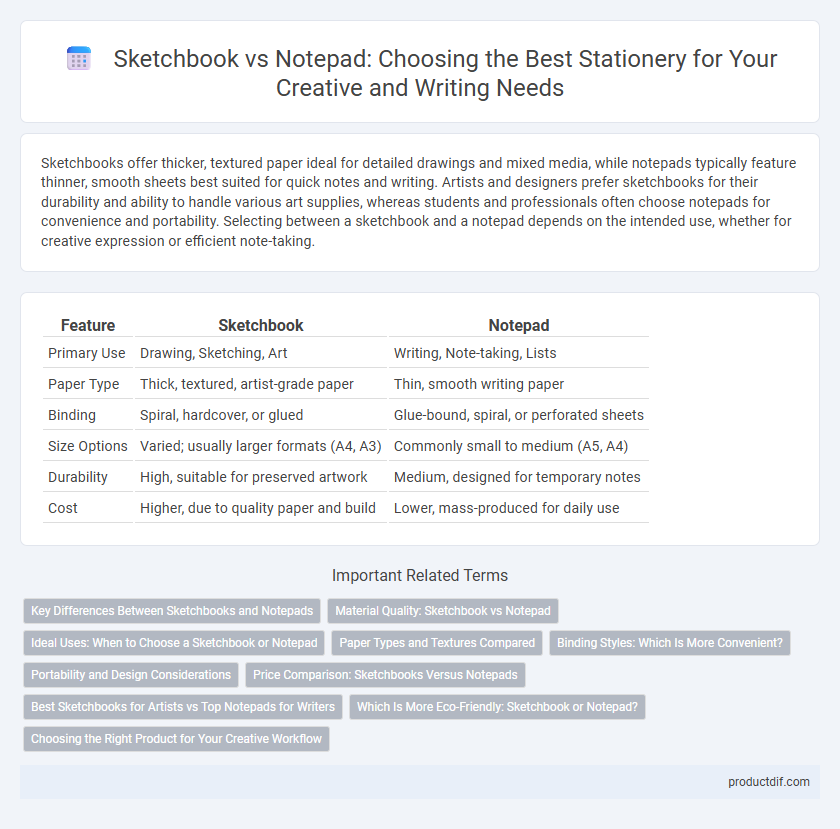Sketchbooks offer thicker, textured paper ideal for detailed drawings and mixed media, while notepads typically feature thinner, smooth sheets best suited for quick notes and writing. Artists and designers prefer sketchbooks for their durability and ability to handle various art supplies, whereas students and professionals often choose notepads for convenience and portability. Selecting between a sketchbook and a notepad depends on the intended use, whether for creative expression or efficient note-taking.
Table of Comparison
| Feature | Sketchbook | Notepad |
|---|---|---|
| Primary Use | Drawing, Sketching, Art | Writing, Note-taking, Lists |
| Paper Type | Thick, textured, artist-grade paper | Thin, smooth writing paper |
| Binding | Spiral, hardcover, or glued | Glue-bound, spiral, or perforated sheets |
| Size Options | Varied; usually larger formats (A4, A3) | Commonly small to medium (A5, A4) |
| Durability | High, suitable for preserved artwork | Medium, designed for temporary notes |
| Cost | Higher, due to quality paper and build | Lower, mass-produced for daily use |
Key Differences Between Sketchbooks and Notepads
Sketchbooks feature thick, textured paper designed to handle various media like pencils, charcoal, and markers, making them ideal for artistic work, while notepads typically have smoother, thinner paper suited for writing and note-taking. Sketchbooks often come with spiral bindings or hard covers to provide a sturdy surface for drawing, whereas notepads are usually glued on one edge for easy page removal. The primary difference lies in their intended use: sketchbooks cater to creative expression with durable paper, and notepads are optimized for quick, everyday writing tasks.
Material Quality: Sketchbook vs Notepad
Sketchbooks typically feature higher-quality paper designed for various media such as graphite, charcoal, and ink, offering increased durability and texture for professional artists. Notepads commonly use thinner, lower-weight paper optimized for quick notes or writing, lacking the thickness and texture necessary for extensive sketching or mixed media work. The choice of material quality directly influences the suitability of each product for drawing precision or everyday note-taking.
Ideal Uses: When to Choose a Sketchbook or Notepad
A sketchbook is ideal for artists, designers, and illustrators who need durable, high-quality paper for detailed drawings, mixed media, or creative brainstorming, allowing for more expressive and refined work. A notepad suits everyday use such as jotting down quick notes, lists, or meeting minutes due to its lightweight, disposable nature and convenience. Choosing a sketchbook ensures longevity and artistic flexibility, while a notepad offers practicality and ease for short-term, casual writing tasks.
Paper Types and Textures Compared
Sketchbooks typically feature thick, textured paper such as heavyweight acid-free or mixed media paper designed for various drawing mediums, offering better absorption and durability for pencils, ink, and watercolor. Notepads usually contain thinner, smoother paper optimized for quick note-taking with pens or pencils, often using standard bond or recycled paper that is less suitable for artistic techniques. The choice between sketchbook and notepad paper significantly impacts the quality and versatility of creative work versus practical writing tasks.
Binding Styles: Which Is More Convenient?
Sketchbooks typically feature spiral or stitched binding, allowing pages to lay flat for easier drawing and better durability, making them ideal for artists and designers. Notepads often use glued or pad binding, which permits easy tearing of pages but may not lie flat, reducing convenience for detailed work. Choosing between the two depends on the need for page stability versus the convenience of removable sheets in daily note-taking or creative projects.
Portability and Design Considerations
Sketchbooks often feature sturdy covers and high-quality paper designed for artists, balancing durability with portability for on-the-go creativity. Notepads usually have lighter, thinner designs prioritizing ease of transport and quick note-taking, making them highly portable for daily use. Design considerations for sketchbooks include paper texture and binding strength, while notepads emphasize compact size and lightweight materials for maximum convenience.
Price Comparison: Sketchbooks Versus Notepads
Sketchbooks generally have a higher price point than notepads due to their thicker, acid-free paper designed for various art mediums. Notepads are more affordable, often featuring thinner, basic paper suited for everyday note-taking and quick sketches. The cost difference reflects the intended use, with sketchbooks offering durability and quality favored by artists, while notepads prioritize convenience and economy for general writing tasks.
Best Sketchbooks for Artists vs Top Notepads for Writers
Best sketchbooks for artists feature high-quality, acid-free paper with varied textures like smooth, cold-pressed, or rough surfaces to accommodate mediums such as graphite, charcoal, and watercolors. Top notepads for writers prioritize portability, ruled or blank layouts for note-taking, and paper weight that supports ink without bleed-through, often including features like perforated pages or spiral bindings for ease of use. While sketchbooks emphasize artistic versatility and durability, notepads focus on practical writing functionality and convenience.
Which Is More Eco-Friendly: Sketchbook or Notepad?
Sketchbooks typically feature higher-quality, thicker paper made from recycled or sustainably sourced materials, making them more eco-friendly than standard notepads, which often use thinner, chemically treated paper. Many sketchbooks utilize soy-based or plant-based inks and have minimal adhesive bindings, reducing their environmental impact. Choosing a spiral-bound or refillable sketchbook further enhances sustainability by allowing reuse and minimizing waste compared to single-use notepads.
Choosing the Right Product for Your Creative Workflow
Choosing between a sketchbook and a notepad depends on your creative workflow and the nature of your projects. Sketchbooks, typically equipped with thicker, textured paper, are ideal for artists using pencils, charcoal, or ink, allowing for detailed illustrations and mixed media work. Notepads, featuring smoother and lighter paper, suit rapid note-taking, brainstorming, and casual sketches, supporting versatility in both professional and educational environments.
Sketchbook vs Notepad Infographic

 productdif.com
productdif.com